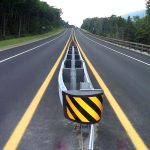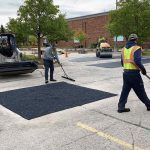A continuing series of articles on fundamental structural engineering analyses. In this article the tensile and compressive stress in structural elements is examined. Since this determination is usually not trivial, computational tools and models provide invaluable analytical insight.
Tension and Compression
Taoist Balance
A previous article introduced the moment of force as a useful engineering calculation. Another fundamental analysis determines the tensile and compressive stresses experienced in a structural member or assembly. These may be experienced as the result of static, constant loads and/or from dynamic, variable loads. In a yin and yang relationship even a taoist would be proud of, compressive and tensile stresses have opposing actions and can be used to achieve balance in a structure.
Determining Axial Stress
Never Push On A Rope
Knowing the expected state of axial stress in a structural member under all conditions is extremely important. Some materials such as soils, concrete, and glass handle compressive stress quite well, but will fail under tensile stress. So if a column placed over load bearing soil is intended to be loaded compressively, unintentionally applied excess tensile loads will lift the column immediately as soil has negligible tensile cohesion. In the equivalent manner, a steel cable can have great tensile strength but will immediately collapse or slacken when excessive compressive loads are applied.
The general mathematical equation for axial stress is:
Stress = Force / Cross-sectional Area, or σ = F/A
In structural engineering, compressive stress is usually indicated as being negative with tensile stress is indicated as positive. So for the simple case of a 1.125 inch diameter cable draped equally mid-length over the smooth (low friction) top of a column 13.5 inches in diameter, with freely hanging 10 pound weights attached to each end of the cable:
Area of the cable ≈ 1 square inch
Area of the column ≈ 1 square foot
Compressive stress in the column = -20 pounds / 1 sq.ft. = -20 p.s.f.
Tensile stress in the cable = +20 pounds / 1 sq.in. = +20 p.s.i.
This is a balanced, straightforward, illustrative example which rarely occurs in realistic engineering applications. It does, however, model how tensile and compressive stress can balance in a structural system.
Complex Structural Analysis
Models Without Designer Clothing
Useful structural engineering practice becomes exponentially more complex as realistic elements and/or loads are added to a structure. Beginning with a horizontal beam loaded mid span and supported on each end, compressive stresses are distributed only in the top horizontal half of the beam as the beam starts to bend under loading. In the bottom horizontal half, the stresses are tensile in nature. The structural model must be able to take this distribution into account, as it can have disastrous consequences otherwise. If the beam material is concrete, it can handle compressive stress in the top horizontal half but will begin to undergo tensile failure in the bottom half. When several such beams are connected in several directions, as in a truss, the stress distribution becomes more complex. Changing the geometry of the beams, the composition, method of attachment and support, multiple loads, and so on creates a complex structural analysis.
Determination of tensile and compressive stress in complex structural applications is clearly not trivial. Extremely useful computational models have been developed to assist with these types of engineering analyses. These are the classical strength of materials method, elasticity methods, and finite element methods. Future articles will delve into the remaining structural stress factors and then into these well-used analytical tools.



Comments are closed